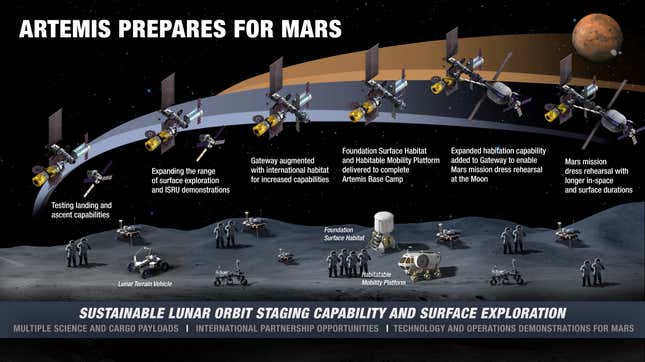As NASA inches closer to returning humans to the Moon and reaching Mars for the first time, the space agency has developed a comprehensive blueprint to establish a long-term human presence at both locations. In an important next step, the plan has passed its first internal review.
NASA’s Architecture Definition Document, along with the six white papers and executive summary released alongside it, is a gigantic technical document that outlines the agency’s plan for sustainably and safely sending crews to the Moon and Mars. The document describes the key international and commercial partnerships, hardware, and operations deemed necessary for these highly complicated—and dangerous—missions. As NASA announced today in a press release, this plan has has successfully passed the agency’s Architecture Concept Review.
Advertisement
The recently concluded review is a “milestone that will help our Moon to Mars strategy unfold through the objectives in missions both near and long term,” said NASA Deputy Administrator Pam Melroy in the press release. “We’re aligned with partners toward a future of expanded economic opportunity, scientific discovery, and greater activity on and around the Moon, and with limitless possibilities deeper in the solar system.”
The 158-page document—published online earlier this month—breaks down the multidecadal plan for humans to explore the Moon and Mars into specific phases. Those phases include getting humans back to the Moon, setting up a human presence on the lunar surface, maintaining that presence for economic and scientific opportunities, and shuttling humans and cargo from the Moon to Mars and back.
Advertisement
And as NASA explains in its press release: “The architecture is not a mission, a manifest, or a set of requirements, but defines the elements—rockets, spacecraft, rovers, spacesuits, communications relays, and more—that will be incrementally developed and delivered to the Moon and Mars for long-term, human-led scientific discovery in deep space.”

Advertisement
Getting humans to the Moon has been a top priority for NASA with the Artemis missions, the first of which successfully tested the new SLS megarocket and the uncrewed Orion spacecraft. As to how the agency plans to stay on the lunar surface has been less certain. While we’ve seen teases of NASA’s goals for a lunar presence, like its plans for a Human Landing System, Moonbuggy, and Artemis base camp, the new document explores the landing and exploration side of the mission—called Foundational Exploration and Sustained Lunar Evolution—more thoroughly.
Specifically, NASA is looking to increase the duration and capabilities of both surface and orbital Moon missions during the foundational period. These missions will serve as test beds for future surface and orbital efforts around Mars. Scientific goals during this part of the Moon-to-Mars strategy will include planetary science as well as human and plant biology.
Advertisement
The foundational phase “will by necessity have to initiate activities and capabilities that will be influenced by the future needs” of the sustained lunar environment phase, and also the humans-to-Mars phase, the document reads. “Such activities include reconnaissance, Mars risk reduction, and initial infrastructure” required to support long-term Moon missions.
While the document is incredibly detailed on everything from hardware to spacecraft to mission goals, NASA is still a ways away from landing humans on the surface of the Moon and even farther away from landing humans on Mars.
Advertisement
NASA launched the uncrewed Artemis 1 mission in November 2022, and while the crewed Artemis 2 mission is scheduled for November 2024, these four astronauts will not land on the lunar surface. It won’t be until Artemis 3, planned for launch in late 2025, that humans could finally return to the lunar surface. As for Mars, that might not happen until the 2030s or 2040s, and possibly even later given the immense complexity of a crewed mission to the Red Planet.
Despite these timelines, the lengthy Architecture Definition Document illustrates just how serious NASA is in maintaining a human presence on the lunar surface, and then using those findings to finally reach Mars.
Advertisement
Want to know more about humanity’s next giant leap in space? Check out our full coverage of NASA’s Artemis Moon program, the new Space Launch System (SLS) rocket and Orion spacecraft, the recently concluded Artemis 1 mission around the Moon, the four-person Artemis 2 crew, NASA and Axiom’s Artemis Moon suit, and the upcoming lunar Gateway space station. And for more spaceflight in your life, follow us on Twitter and bookmark Gizmodo’s dedicated Spaceflight page.
Services Marketplace – Listings, Bookings & Reviews